open bonnet Alfa Romeo 147 2007 Owner handbook (in English)
[x] Cancel search | Manufacturer: ALFA ROMEO, Model Year: 2007, Model line: 147, Model: Alfa Romeo 147 2007Pages: 291, PDF Size: 5.52 MB
Page 8 of 291
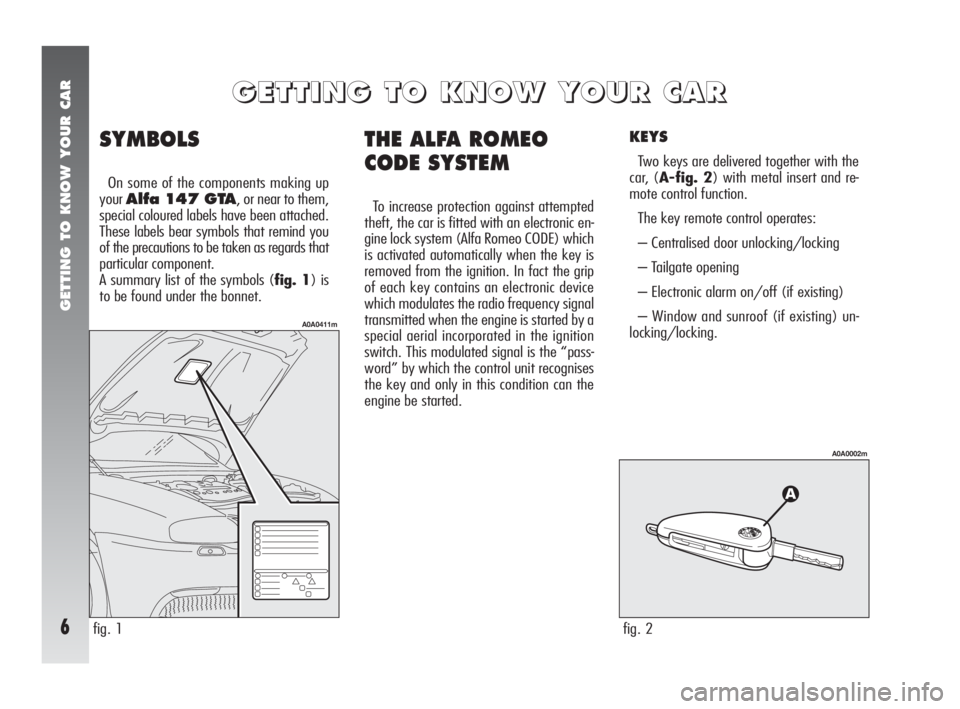
GETTING TO KNOW YOUR CAR
6
THE ALFA ROMEO
CODE SYSTEM
To increase protection against attempted
theft, the car is fitted with an electronic en-
gine lock system (Alfa Romeo CODE) which
is activated automatically when the key is
removed from the ignition. In fact the grip
of each key contains an electronic device
which modulates the radio frequency signal
transmitted when the engine is started by a
special aerial incorporated in the ignition
switch. This modulated signal is the “pass-
word” by which the control unit recognises
the key and only in this condition can the
engine be started.
KEYS
Two keys are delivered together with the
car, (A-fig. 2) with metal insert and re-
mote control function.
The key remote control operates:
– Centralised door unlocking/locking
– Tailgate opening
– Electronic alarm on/off (if existing)
– Window and sunroof (if existing) un-
locking/locking.
G G
E E
T T
T T
I I
N N
G G
T T
O O
K K
N N
O O
W W
Y Y
O O
U U
R R
C C
A A
R R
fig. 2
A0A0002m
fig. 1
A0A0411m
SYMBOLS
On some of the components making up
your
Alfa 147 GTA, or near to them,
special coloured labels have been attached.
These labels bear symbols that remind you
of the precautions to be taken as regards that
particular component.
A summary list of the symbols (fig. 1) is
to be found under the bonnet.
Page 13 of 291
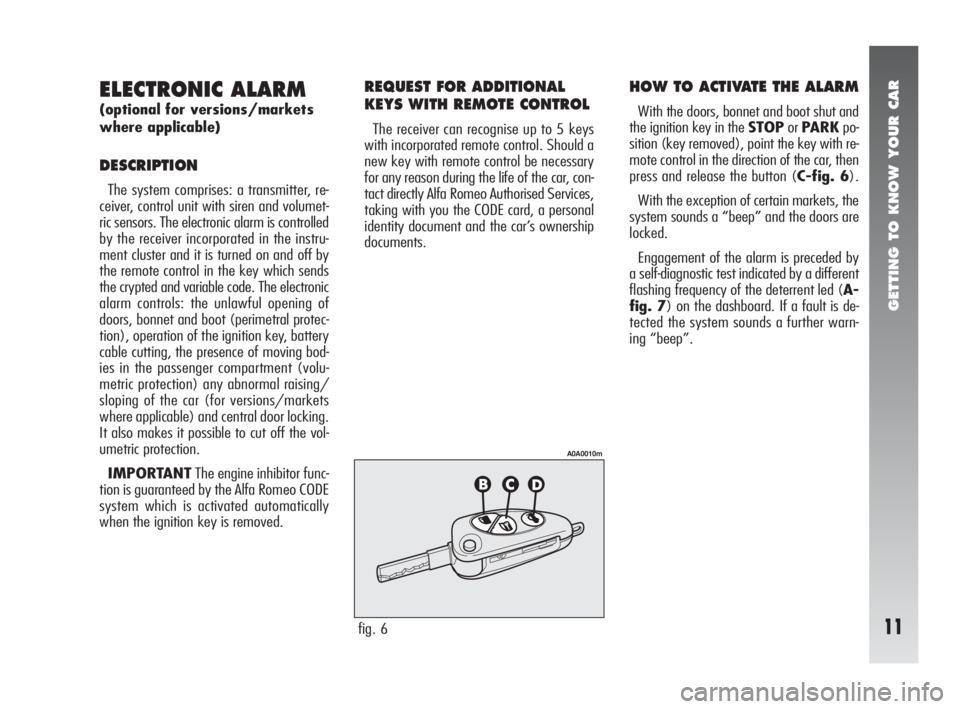
GETTING TO KNOW YOUR CAR
11
ELECTRONIC ALARM
(optional for versions/markets
where applicable)
DESCRIPTION
The system comprises: a transmitter, re-
ceiver, control unit with siren and volumet-
ric sensors. The electronic alarm is controlled
by the receiver incorporated in the instru-
ment cluster and it is turned on and off by
the remote control in the key which sends
the crypted and variable code. The electronic
alarm controls: the unlawful opening of
doors, bonnet and boot (perimetral protec-
tion), operation of the ignition key, battery
cable cutting, the presence of moving bod-
ies in the passenger compartment (volu-
metric protection) any abnormal raising/
sloping of the car (for versions/markets
where applicable) and central door locking.
It also makes it possible to cut off the vol-
umetric protection.
IMPORTANTThe engine inhibitor func-
tion is guaranteed by the Alfa Romeo CODE
system which is activated automatically
when the ignition key is removed.
REQUEST FOR ADDITIONAL
KEYS WITH REMOTE CONTROL
The receiver can recognise up to 5 keys
with incorporated remote control. Should a
new key with remote control be necessary
for any reason during the life of the car, con-
tact directly Alfa Romeo Authorised Services,
taking with you the CODE card, a personal
identity document and the car’s ownership
documents.
HOW TO ACTIVATE THE ALARM
With the doors, bonnet and boot shut and
the ignition key in the STOPorPARKpo-
sition (key removed), point the key with re-
mote control in the direction of the car, then
press and release the button (C-fig. 6).
With the exception of certain markets, the
system sounds a “beep” and the doors are
locked.
Engagement of the alarm is preceded by
a self-diagnostic test indicated by a different
flashing frequency of the deterrent led (A-
fig. 7) on the dashboard. If a fault is de-
tected the system sounds a further warn-
ing “beep”.
fig. 6
A0A0010m
Page 15 of 291

GETTING TO KNOW YOUR CAR
13
– if the led continues flashing, but at dif-
ferent intervals than normal, this means that
different attempts to break in have occurred.
Through the number of flashes it is possi-
ble to identify the type of attempt:
1 flash:one or more doors
2 flashes:tailgate
3 flashes:bonnet
4 flashes:ultrasounds
5 flashes:abnormal vehicle lift-
ing/sloping (for ver-
sions/markets where ap-
plicable)
6 flashes:tampering with car starting
cables
7 flashes:tampering with battery ca-
bles or cutting emergency
key cables
8 flashes:connection line to sensors
and siren
9 flashes:at least three causes of
alarm.WHEN THE ALARM
IS TRIGGERED
When the system is on, the alarm comes
into action in the following cases:
– opening of one of the doors, bonnet or
tailgate;
– disconnection of the battery or section-
ing of electric cables;
– intrusion in the passenger compartment,
for example breakage of windows (volu-
metric protection);
– attempt to start the engine (key in
MARposition);
– abnormal car lifting/sloping (for ver-
sions/markets where applicable).
Depending on the markets, the cutting in
of the alarm causes operation of the siren
and hazard warning lights (for about 26 sec-
onds). The ways of operating and the num-
ber of cycles may vary depending on the
markets.
A maximum number of cycles is however
envisaged.
Once the alarm cycle has ended, the sys-
tem resumes its normal control function.
VOLUMETRIC PROTECTION
To make sure that the protection system
works correctly the side windows and sun-
roof (if fitted) must be properly shut.
The function can be cut off (if, for exam-
ple, leaving animals in the car) carrying out
the following operations in rapid succession:
starting from the condition with the igni-
tion key at MAR, move the key to STOP,
then immediately back to MARand then
toSTOPagain, then remove the ignition
key.
The deterrent led (A-fig. 7) on the dash-
board lights up for about 2 seconds to con-
firm that the function has been cut off.
To restore volumetric protection, move and
keep the ignition key at MARfor over 30
seconds.
If, with the volumetric protection function
deactivated, an electric control controlled by
the ignition key at MARis required (e.g.
power windows) turn the key to MAR, op-
erate the control and move the key to
STOPin a maximum time of 30 seconds.
This way volumetric protection is not re-
stored.
Page 52 of 291
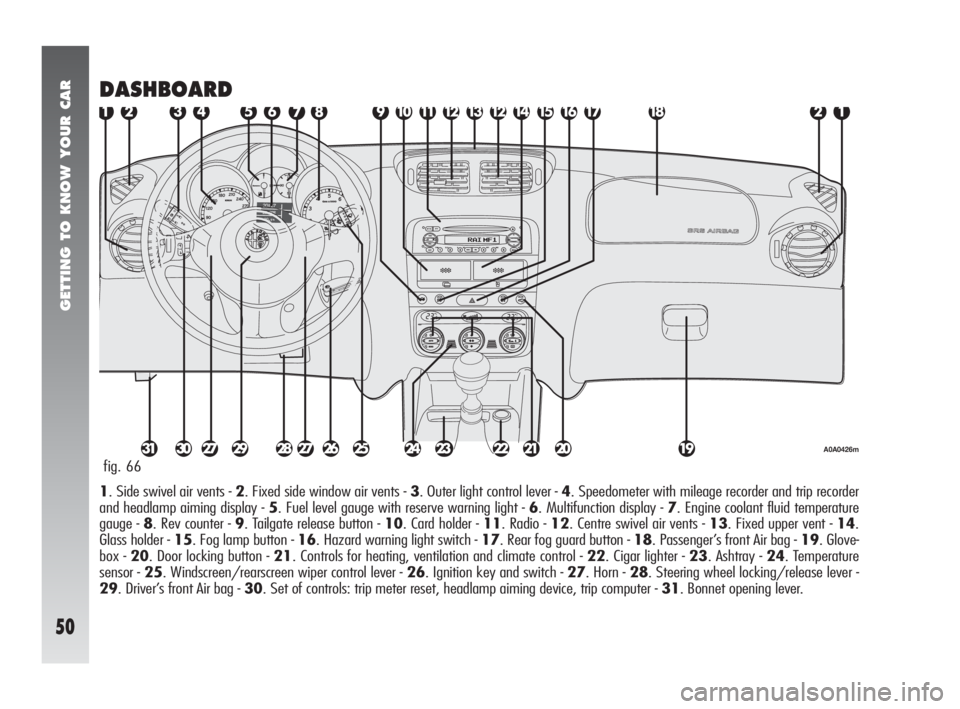
GETTING TO KNOW YOUR CAR
50
DASHBOARD
1. Side swivel air vents - 2. Fixed side window air vents - 3. Outer light control lever - 4. Speedometer with mileage recorder and trip recorder
and headlamp aiming display - 5. Fuel level gauge with reserve warning light - 6. Multifunction display - 7. Engine coolant fluid temperature
gauge - 8. Rev counter - 9. Tailgate release button - 10. Card holder - 11. Radio - 12. Centre swivel air vents - 13. Fixed upper vent - 14.
Glass holder - 15. Fog lamp button - 16. Hazard warning light switch - 17. Rear fog guard button - 18. Passenger’s front Air bag - 19. Glove-
box - 20. Door locking button - 21. Controls for heating, ventilation and climate control - 22. Cigar lighter - 23. Ashtray - 24. Temperature
sensor - 25. Windscreen/rearscreen wiper control lever - 26. Ignition key and switch - 27. Horn - 28. Steering wheel locking/release lever -
29. Driver’s front Air bag - 30. Set of controls: trip meter reset, headlamp aiming device, trip computer - 31. Bonnet opening lever. fig. 66
A0A0426m
Page 132 of 291
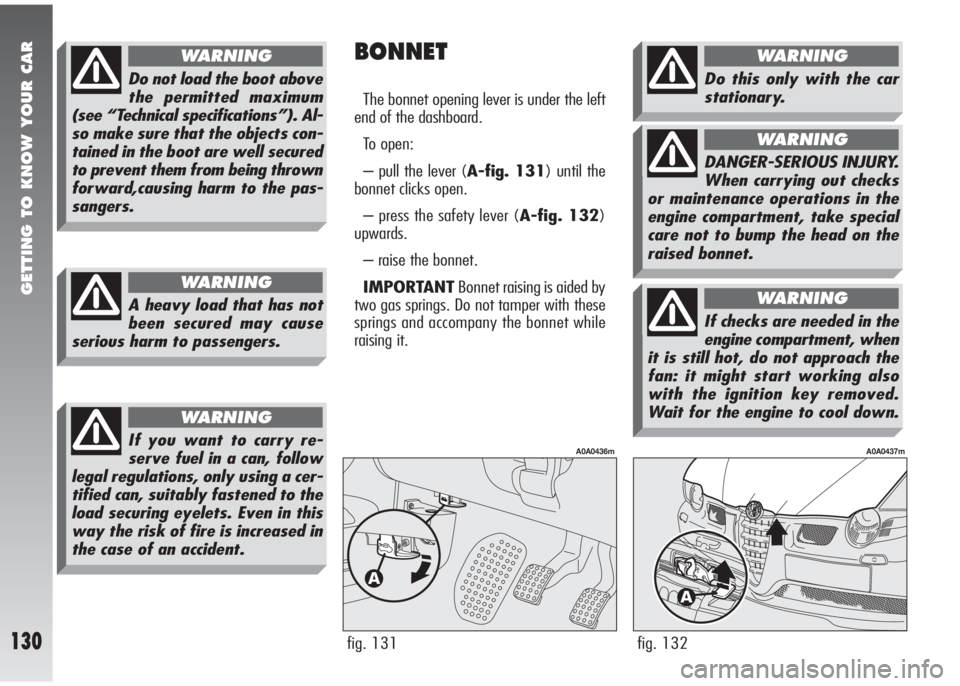
GETTING TO KNOW YOUR CAR
130fig. 132
A0A0437m
BONNET
The bonnet opening lever is under the left
end of the dashboard.
To open:
– pull the lever (A-fig. 131) until the
bonnet clicks open.
– press the safety lever (A-fig. 132)
upwards.
– raise the bonnet.
IMPORTANTBonnet raising is aided by
two gas springs. Do not tamper with these
springs and accompany the bonnet while
raising it.
fig. 131
A0A0436m
A heavy load that has not
been secured may cause
serious harm to passengers.
WARNING
Do not load the boot above
the permitted maximum
(see “Technical specifications”). Al-
so make sure that the objects con-
tained in the boot are well secured
to prevent them from being thrown
forward,causing harm to the pas-
sangers.
WARNING
If you want to carry re-
serve fuel in a can, follow
legal regulations, only using a cer-
tified can, suitably fastened to the
load securing eyelets. Even in this
way the risk of fire is increased in
the case of an accident.
WARNING
Do this only with the car
stationary.
WARNING
DANGER-SERIOUS INJURY.
When carrying out checks
or maintenance operations in the
engine compartment, take special
care not to bump the head on the
raised bonnet.
WARNING
If checks are needed in the
engine compartment, when
it is still hot, do not approach the
fan: it might start working also
with the ignition key removed.
Wait for the engine to cool down.
WARNING
Page 133 of 291
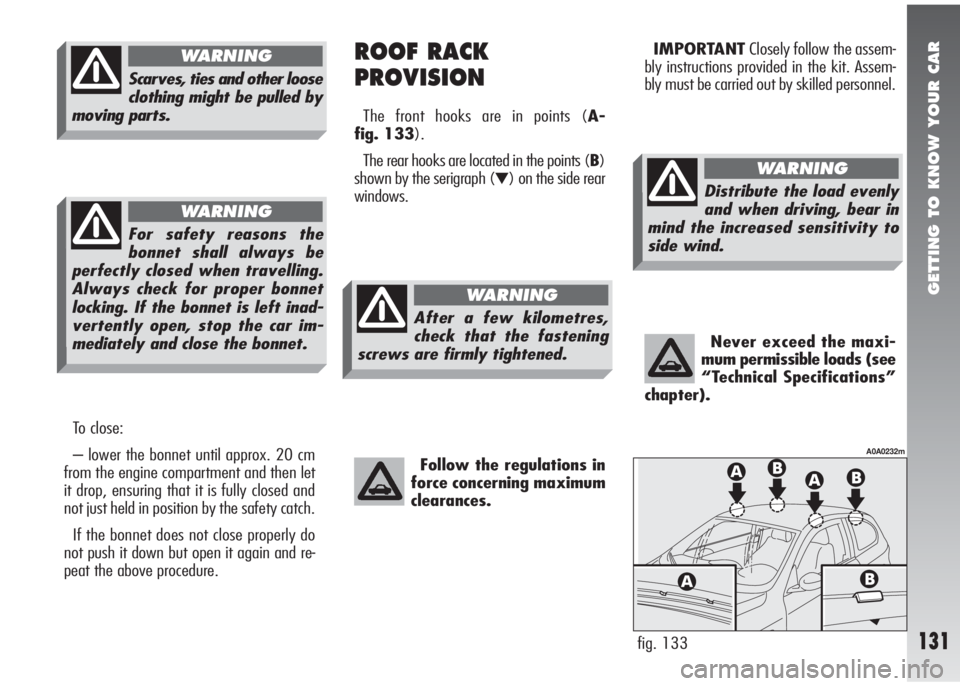
GETTING TO KNOW YOUR CAR
131
To close:
– lower the bonnet until approx. 20 cm
from the engine compartment and then let
it drop, ensuring that it is fully closed and
not just held in position by the safety catch.
If the bonnet does not close properly do
not push it down but open it again and re-
peat the above procedure.
Scarves, ties and other loose
clothing might be pulled by
moving parts.
WARNING
For safety reasons the
bonnet shall always be
perfectly closed when travelling.
Always check for proper bonnet
locking. If the bonnet is left inad-
vertently open, stop the car im-
mediately and close the bonnet.
WARNING
ROOF RACK
PROVISION
The front hooks are in points (A-
fig. 133).
The rear hooks are located in the points (B)
shown by the serigraph (
▼) on the side rear
windows.
Follow the regulations in
force concerning maximum
clearances.
IMPORTANTClosely follow the assem-
bly instructions provided in the kit. Assem-
bly must be carried out by skilled personnel.
Never exceed the maxi-
mum permissible loads (see
“Technical Specifications”
chapter).
fig. 133
A0A0232m
After a few kilometres,
check that the fastening
screws are firmly tightened.
WARNING
Distribute the load evenly
and when driving, bear in
mind the increased sensitivity to
side wind.
WARNING
Page 243 of 291
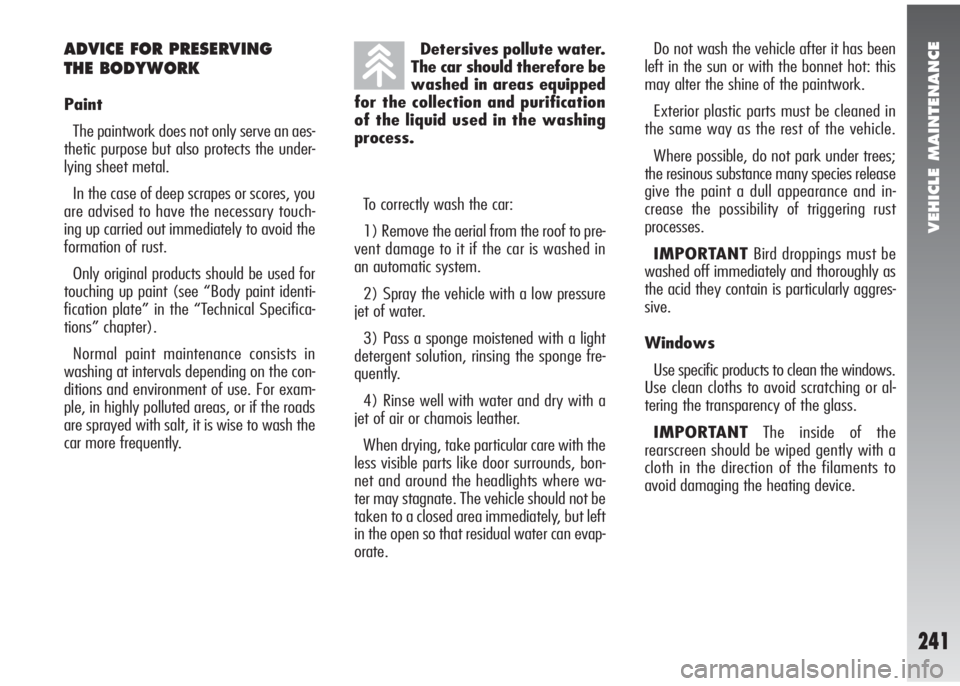
VEHICLE MAINTENANCE
241
ADVICE FOR PRESERVING
THE BODYWORK
Paint
The paintwork does not only serve an aes-
thetic purpose but also protects the under-
lying sheet metal.
In the case of deep scrapes or scores, you
are advised to have the necessary touch-
ing up carried out immediately to avoid the
formation of rust.
Only original products should be used for
touching up paint (see “Body paint identi-
fication plate” in the “Technical Specifica-
tions” chapter).
Normal paint maintenance consists in
washing at intervals depending on the con-
ditions and environment of use. For exam-
ple, in highly polluted areas, or if the roads
are sprayed with salt, it is wise to wash the
car more frequently.Do not wash the vehicle after it has been
left in the sun or with the bonnet hot: this
may alter the shine of the paintwork.
Exterior plastic parts must be cleaned in
the same way as the rest of the vehicle.
Where possible, do not park under trees;
the resinous substance many species release
give the paint a dull appearance and in-
crease the possibility of triggering rust
processes.
IMPORTANTBird droppings must be
washed off immediately and thoroughly as
the acid they contain is particularly aggres-
sive.
Windows
Use specific products to clean the windows.
Use clean cloths to avoid scratching or al-
tering the transparency of the glass.
IMPORTANTThe inside of the
rearscreen should be wiped gently with a
cloth in the direction of the filaments to
avoid damaging the heating device. Detersives pollute water.
The car should therefore be
washed in areas equipped
for the collection and purification
of the liquid used in the washing
process.
To correctly wash the car:
1) Remove the aerial from the roof to pre-
vent damage to it if the car is washed in
an automatic system.
2) Spray the vehicle with a low pressure
jet of water.
3) Pass a sponge moistened with a light
detergent solution, rinsing the sponge fre-
quently.
4) Rinse well with water and dry with a
jet of air or chamois leather.
When drying, take particular care with the
less visible parts like door surrounds, bon-
net and around the headlights where wa-
ter may stagnate. The vehicle should not be
taken to a closed area immediately, but left
in the open so that residual water can evap-
orate.
Page 262 of 291
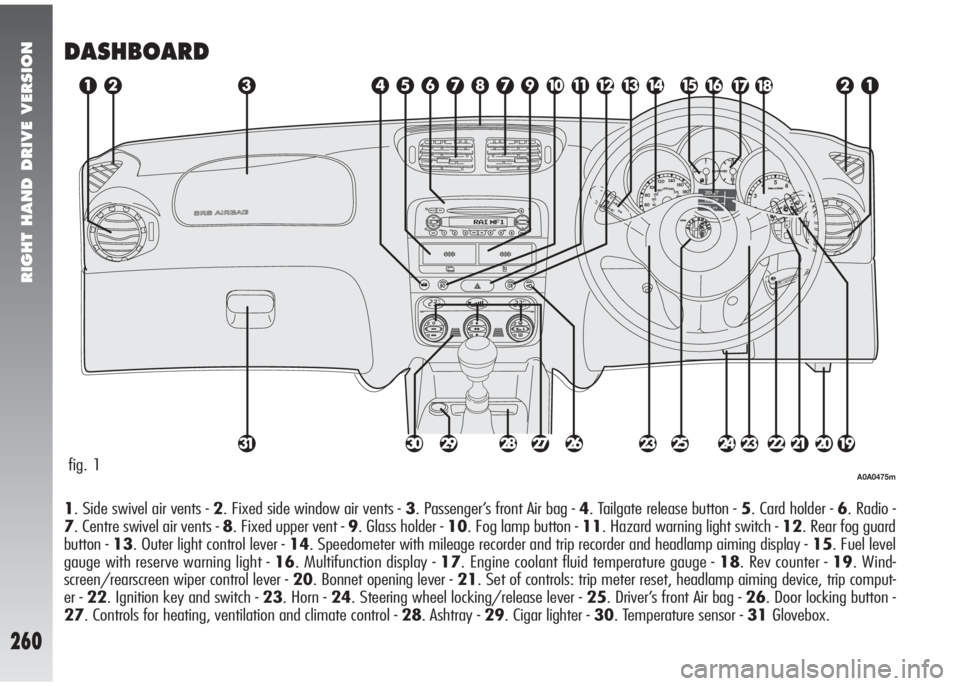
RIGHT HAND DRIVE VERSION
260
DASHBOARD
1. Side swivel air vents - 2. Fixed side window air vents - 3. Passenger’s front Air bag - 4. Tailgate release button - 5. Card holder - 6. Radio -
7. Centre swivel air vents - 8. Fixed upper vent - 9. Glass holder - 10. Fog lamp button - 11. Hazard warning light switch - 12. Rear fog guard
button - 13. Outer light control lever - 14. Speedometer with mileage recorder and trip recorder and headlamp aiming display - 15. Fuel level
gauge with reserve warning light - 16. Multifunction display - 17. Engine coolant fluid temperature gauge - 18. Rev counter - 19. Wind-
screen/rearscreen wiper control lever - 20. Bonnet opening lever - 21. Set of controls: trip meter reset, headlamp aiming device, trip comput-
er - 22. Ignition key and switch - 23. Horn - 24. Steering wheel locking/release lever - 25. Driver’s front Air bag - 26. Door locking button -
27. Controls for heating, ventilation and climate control - 28. Ashtray - 29. Cigar lighter - 30. Temperature sensor - 31Glovebox.
fig. 1A0A0475m
Page 273 of 291
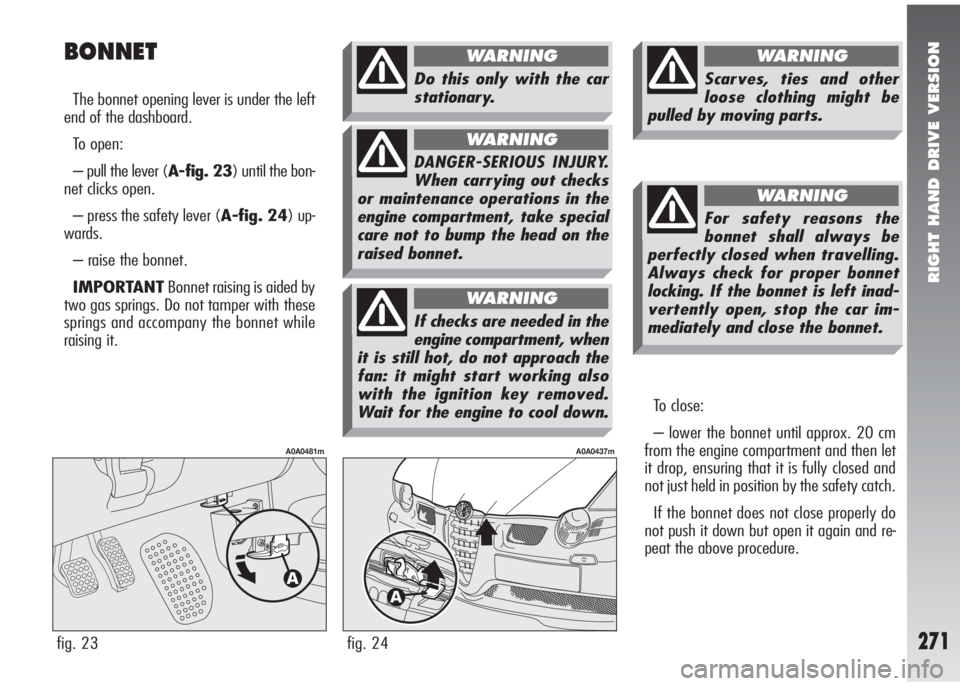
RIGHT HAND DRIVE VERSION
271
BONNET
The bonnet opening lever is under the left
end of the dashboard.
To open:
– pull the lever (A-fig. 23) until the bon-
net clicks open.
– press the safety lever (A-fig. 24) up-
wards.
– raise the bonnet.
IMPORTANTBonnet raising is aided by
two gas springs. Do not tamper with these
springs and accompany the bonnet while
raising it.
fig. 23
A0A0481m
fig. 24
A0A0437m
To close:
– lower the bonnet until approx. 20 cm
from the engine compartment and then let
it drop, ensuring that it is fully closed and
not just held in position by the safety catch.
If the bonnet does not close properly do
not push it down but open it again and re-
peat the above procedure.
Scarves, ties and other
loose clothing might be
pulled by moving parts.
WARNING
Do this only with the car
stationary.
WARNING
For safety reasons the
bonnet shall always be
perfectly closed when travelling.
Always check for proper bonnet
locking. If the bonnet is left inad-
vertently open, stop the car im-
mediately and close the bonnet.
WARNING
DANGER-SERIOUS INJURY.
When carrying out checks
or maintenance operations in the
engine compartment, take special
care not to bump the head on the
raised bonnet.
WARNING
If checks are needed in the
engine compartment, when
it is still hot, do not approach the
fan: it might start working also
with the ignition key removed.
Wait for the engine to cool down.
WARNING
Page 276 of 291
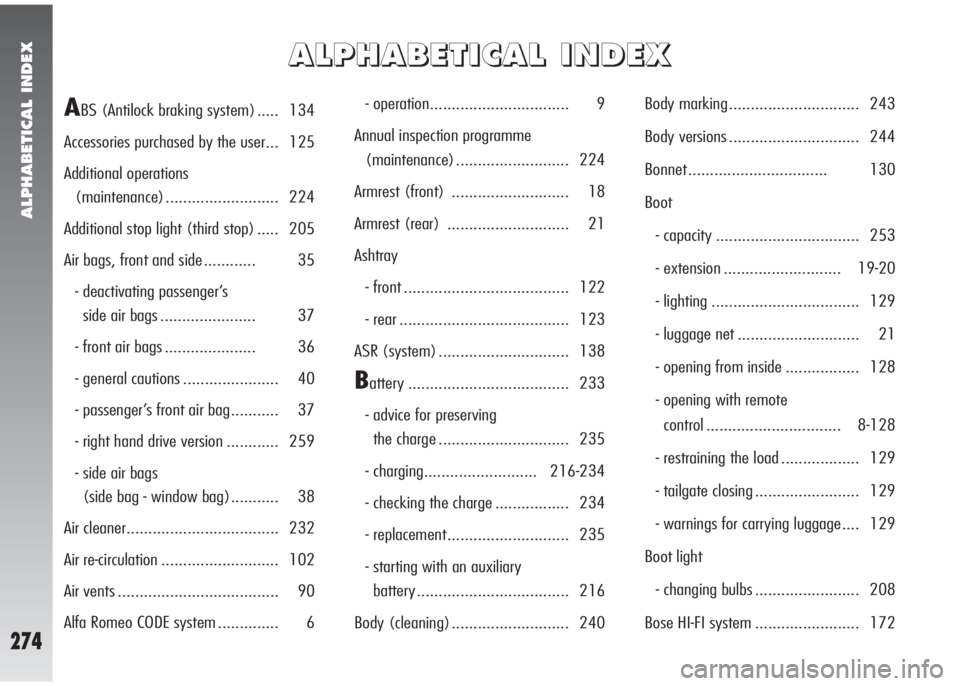
ALPHABETICAL INDEX
274
A A
L L
P P
H H
A A
B B
E E
T T
I I
C C
A A
L L
I I
N N
D D
E E
X X
ABS (Antilock braking system) ..... 134
Accessories purchased by the user... 125
Additional operations
(maintenance) .......................... 224
Additional stop light (third stop) ..... 205
Air bags, front and side ............ 35
- deactivating passenger’s
side air bags ...................... 37
- front air bags ..................... 36
- general cautions ...................... 40
- passenger’s front air bag........... 37
- right hand drive version ............ 259
- side air bags
(side bag - window bag)........... 38
Air cleaner................................... 232
Air re-circulation ........................... 102
Air vents ..................................... 90
Alfa Romeo CODE system .............. 6- operation................................ 9
Annual inspection programme
(maintenance) .......................... 224
Armrest (front) ........................... 18
Armrest (rear) ............................ 21
Ashtray
- front ...................................... 122
- rear ....................................... 123
ASR (system) .............................. 138
Battery ..................................... 233
- advice for preserving
the charge .............................. 235
- charging.......................... 216-234
- checking the charge ................. 234
- replacement............................ 235
- starting with an auxiliary
battery ................................... 216
Body (cleaning) ........................... 240Body marking.............................. 243
Body versions .............................. 244
Bonnet ................................ 130
Boot
- capacity ................................. 253
- extension ........................... 19-20
- lighting .................................. 129
- luggage net ............................ 21
- opening from inside ................. 128
- opening with remote
control ............................... 8-128
- restraining the load .................. 129
- tailgate closing ........................ 129
- warnings for carrying luggage.... 129
Boot light
- changing bulbs ........................ 208
Bose HI-FI system ........................ 172